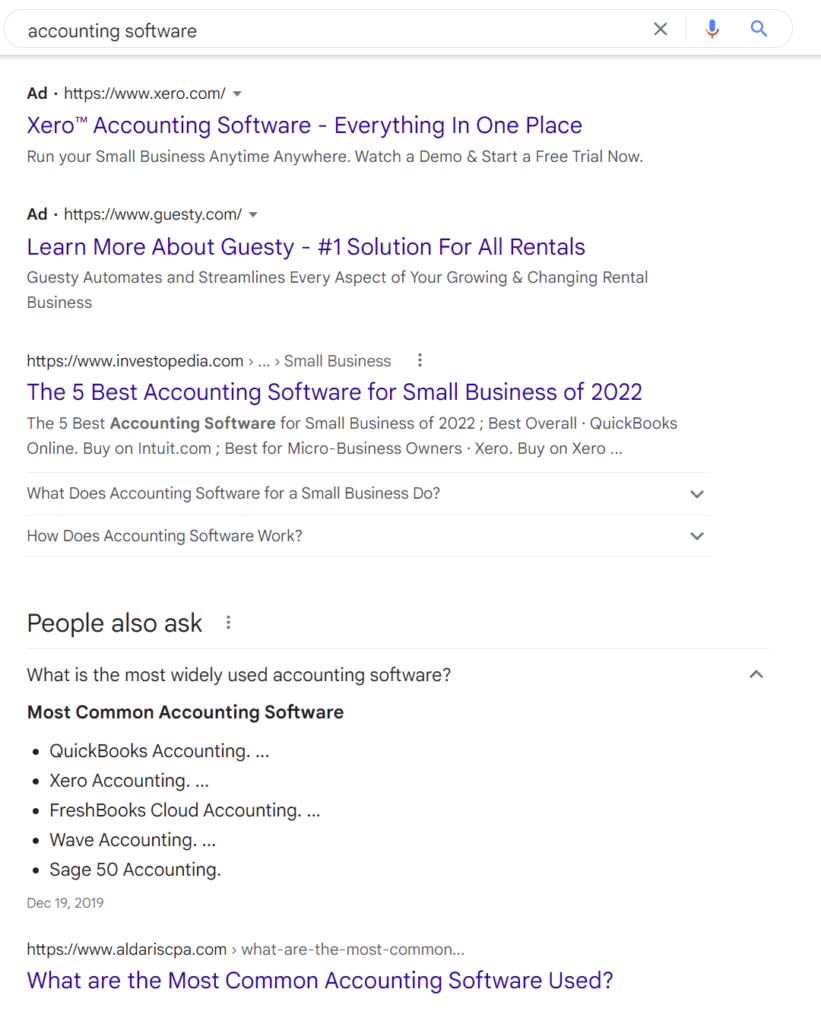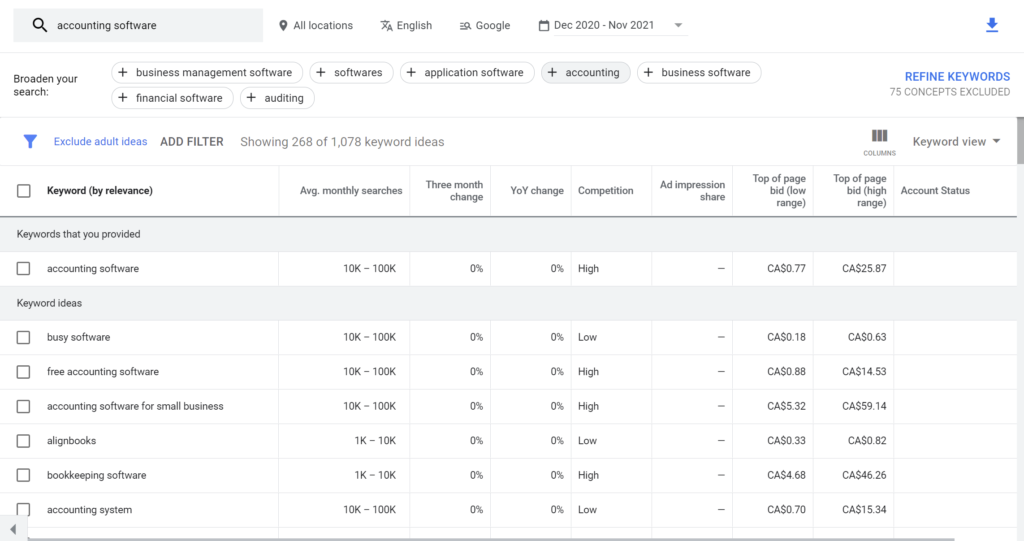Search Engine Marketing (SEM for short) is an extremely valuable technique for B2B companies if done right. At any given time, 95% of B2B decision-makers are not currently looking to buy. This presents an interesting challenge for revenue leaders. With outbound and display campaigns, it’s very easy to spend effort on contacting individuals who have no interest in doing business with you at the moment, even if they meet your exact buyer persona. Enter SEM. Typically, when a searcher enters a phrase such as “Best Small Business Accounting Software 2022”, they are communicating buying intent. Having your product presented to them at such a time can be extremely valuable. This form of marketing is where Google has made most of its revenue. In this post, we will be exploring best practices for implementing B2B search marketing campaigns.
SEO vs SEM: B2B Search Marketing 101
There are two primary ways to have your business appear in search results on the top search engines, Google and Bing. You can either have your page come up organically through SEO (Search Engine Optimization) or pay to show in the paid search results through SEM. While you may be thinking to yourself, great why not use the free option—SEO is often highly competitive and can be a challenge to appear in search results within a few months. For more information on SEO, check out our post on Search Engine Positioning 101.
SEM allows you to bid on having your ad appear for certain keywords and searches immediately. This can be very helpful if you are looking to appear in highly competitive search terms such as “Best Accounting Software”, where there will be other competitors showing paid ads. Furthermore, if you are on a tight timeline and looking for results quickly, SEM can also deliver the traffic you’re looking for immediately. This post will focus on SEM B2B search marketing.
To illustrate the differences between the two, here is the results page for searching “Accounting Software” in Google. The paid search result from Xero has taken the top spot, followed by a paid result from Guesty. These are both examples of SEM. Below that, Investopedia has the top-ranking organic result. Further down the page, you can also see Google suggesting similar searches and answers before showing additional organic results. Appearing in these areas relates to SEO.

Top 5 Tips for B2B Search Marketing
#1) Understanding The Major Search Engines
When it comes to B2B Search Marketing, it is important to understand what options you have available to display ads. Google has more than 91% of the search engine market share as of December 2021. As a result, it is the most important search engine platform to consider. Beyond Google, there is also Bing and Yahoo, and DuckDuckGo which are also used in English-speaking countries.
Google, with its high search volumes, will most likely be the best platform for you to start building campaigns on. Due to its well-developed platform and extensive options to target your ad campaigns, it remains a compelling option.
Beyond Google, another option to consider in the world of B2B is Bing. Owned by Microsoft, Bing is set as the default search engine in Windows, and Microsoft Edge. Microsoft also owns LinkedIn, having recently implemented targetting features within Bing from Linkedin. This allows you to target specific B2B buyers more easily based on organization size, industry, etc. This is often information that Google doesn’t possess with such accuracy.
#2) Conducting Effective Keyword Research
The cornerstone of any effective search engine campaign is effective keyword selection. Finding and selecting the right keywords to display your ads for is paramount. Keywords range greatly when it comes to accuracy, buyer intent, and competition. Purely informational keywords such as “How to cut a cucumber”, have little commercial intent. Therefore there is no one willing to pay to appear in these searches. However a similar search, such as “best knives for bread”, may communicate that I am looking to purchase a knife. Advertisers are willing to sponsor their knives to appear in that search.
To build an effective campaign, you must consider what potential searches you are looking to appear in. As a B2B SaaS company, appearing in the search term “best accounting software” will be much more valuable than the search “top B2B companies”. One searcher is looking to purchase accounting software potentially, the other is doing more general research.
One of the best free tools to conduct SEM keyword research is Google’s Keyword Planner. Located right in Google Ads under Tools & Settings > Planning. It allows you to easily input a search term and generate related keywords to potentially target.

As shown above, by inputting the term “Accounting Software” into Google’s Keyword Planner, we are able to see a list of related searches worldwide, including approximate volumes, trends, competition estimates, and bid ranges. Even similar searches can have very different costs. Ranking for “accounting software for small business” costs 4x as much compared to “accounting system” which is much more general and has lower intent. Building out an extensive list of keywords to target at this early stage is vital. Targetting very specific, less obvious keywords that your competition may not have on their radar can produce massive results. For more advanced information on keyword research, we recommend tools such as SEMRush.
Read our post on B2B keyword research for further insight.
#3) Building High-Quality Targeted Ads
Before diving into search engine marketing for B2B, we recommend having an understanding of how the Google bid algorithm works. This is a helpful video on the topic. In short, Google takes a variety of factors into consideration when selecting which ads to display and in what order—primarily bid amount and quality. Google wants to show search ads that are relevant to get searchers the answers they are looking for. Even if you bid highly for the term “accounting software”, but your ad talks about web design software, Google might select a more relevant ad with a lower bid.
As a result, having ads that are targeted to specific keywords is another important factor in success. As a further example, you would likely wish to display different content to someone searching for “how to do small business accounting,” compared to someone searching for “small business accounting software”. The first would likely benefit from a guide or lesson series your company produces, the second might be ready to buy now. As a result, the difference in intent could warrant different ads, and even completely different landing pages. Take the time to answer the question, what kind of information would I be searching for with this keyword, in order to build an effective ad.
For more information on quality scores and how they can impact your performance, check out this post from Google.
#4) Remarketing with Display Ads
B2B buyers love doing research more than other shoppers. Often they have a duty to their organization to take the time to make an informed decision. This decision-making process may span the course of an entire quarter or even fiscal year before the budget is allocated. The buyer may visit your site once and then forget about your product as an option when the time comes to make a decision.
Remarketing can be an extremely effective way to ensure you stay top of mind after they visit your site or landing page. By creating a specific audience within Google Ads and Google Analytics, you can remarket to individuals for up to 540 days after they visit your site. This can have a massive impact on the ROI you see from your ad campaigns over time. By carefully creating retargeting ads through display ads and even through other Google platforms such as Youtube, you can be sure to remain top of mind as the buyer moves through the various decision-making stages and finally makes a purchase.
B2B Search Marketing: Getting Started + Bonus Tip
Search marketing in the world of B2B can be extremely valuable. It stands out as one of the most effective ways to target buyers when they are looking for more information, or are ready to make a decision.
As a bonus tip, monitoring and continuously improving your campaigns is vital to success. Unlike what many believe, SEM does not involve setting and forgetting it. Google will often gladly take your money and provide you with few results in return. To achieve strong performance, especially in competitive segments, it is essential that you constantly monitor performance in an effort to generate improved results. By seeing which keywords, ads, landing pages, and campaigns are performing well—and pruning the ones that aren’t—you can be sure to make the most of your budget.
-1024x320.png)





